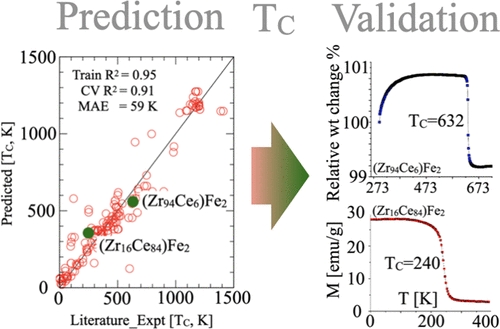博文
研究人员利用人工智能寻找不含关键元素的新型磁性材料
||
研究人员利用人工智能寻找不含关键元素的新型磁性材料
诸平
据美国能源部艾姆斯国家实验室(U.S. Department of Energy Ames National Laboratory)2023年9月5日提供的消息,该实验室的研究人员利用人工智能寻找不含关键元素的新型磁性材料(Researchers use AI to find new magnetic materials without critical elements)。
Photo of a magnet. Credit: U.S. Department of Energy Ames National Laboratory
来自艾姆斯国家实验室的一组科学家开发了一种新的机器学习模型(machine learning model简称ML Model),用于发现无关键元素的永磁材料。该模型预测了新材料组合的居里温度(Curie temperature)。这是利用人工智能预测新型永磁材料的重要的第一步。该模型增加了该团队最近开发的发现热力学稳定稀土材料的能力。相关研究于2023年8月2日已经在《材料化学》(Chemistry of Materials)杂志网站发表——Prashant Singh, Tyler Del Rose, Andriy Palasyuk, Yaroslav Mudryk. Physics-Informed Machine-Learning Prediction of Curie Temperatures and Its Promise for Guiding the Discovery of Functional Magnetic Materials. Chemistry of Materials, 2023, 35(16): 6304–6312. DOI: 10.1021/acs.chemmater.3c00892. Publication Date: August 2, 2023. https://pubs.acs.org/doi/10.1021/acs.chemmater.3c00892
参与此项研究的除了艾姆斯国家实验室的研究人员之外,还有来自美国爱荷华州立大学(Iowa State University, Ames, Iowa 50011 United States)以及美国爱荷华艾姆斯的关键材料研究所(Critical Materials Institute, Ames, Iowa 50011, United States)的研究人员。
高性能磁铁对风能(wind energy)、数据存储(data storage)、电动汽车(electric vehicles)和磁制冷(magnetic refrigeration)等技术至关重要。这些磁铁含有关键材料,如钴和稀土元素(如钕和镝)。这些材料需求量很大,但供应有限。这种情况促使研究人员寻找减少关键材料的方法来设计新的磁性材料。
机器学习(ML)是人工智能(artificial intelligence)的一种形式。它是由计算机算法驱动的,这些算法使用数据和试错算法来不断改进其预测。该团队使用居里温度的实验数据和理论建模来训练机器学习算法(ML algorithm)。居里温度是材料保持磁性的最高温度。
艾姆斯实验室的科学家、该研究小组的资深领导者雅罗斯拉夫·穆德瑞克(Yaroslav Mudryk)说:“发现具有高居里温度的化合物是发现可以在高温下保持磁性的材料的重要的第一步。这一方面不仅对永磁体的设计至关重要,而且对其他功能磁性材料的设计也同样至关重要。”
根据雅罗斯拉夫·穆德瑞克的说法,发现新材料是一项具有挑战性的活动,因为此类研究传统上是基于实验的,这既昂贵又耗时。然而,使用ML方法不仅可以节省时间,而且可以节省资源。
艾姆斯实验室的科学家兼研究小组成员普拉桑特·辛格(Prashant Singh)解释说,这项工作的主要部分是利用基础科学开发ML模型。该团队使用实验已知的磁性材料训练他们的ML模型。有关这些材料的信息建立了若干电子和原子结构特征与居里温度之间的关系。这些模式给计算机提供了寻找潜在候选材料的基础。
为了测试这个模型,研究小组使用了基于铈(Ce)、锆(Zr)和铁(Fe)的化合物。这个想法是由艾姆斯实验室的科学家、研究小组成员安德里·帕拉苏克(Andriy Palasyuk)提出的。他想把重点放在基于地球上丰富元素的未知磁铁材料上。安德里·帕拉苏克说:“下一个超级磁铁不仅要有卓越的性能,而且要依靠丰富的国内元素成分。”
安德里·帕拉苏克与艾姆斯实验室的另一位科学家、研究小组成员泰勒·德尔·罗斯(Tyler Del Rose)合作,合成并表征了这;类合金材料。他们发现ML模型在预测候选材料的居里温度方面是成功的。这一成功是为未来技术应用创造高通量设计新型永磁体重要的第一步。
普拉桑特·辛格说:“我们正在为可持续发展的未来编写基于物理知识的机器学习(machine learning )。”
上述介绍,仅供参考。欲了解更多信息,敬请注意浏览原文或者相关报道。
High-performance permanent magnets with a high Curie temperature, containing less critical materials, are integral to zero-carbon energy solutions. We built a machine-learning model trained over available experimentally measured Curie temperature values to predict the TC of multicomponent magnetic materials. We chose two compositions from a pseudo-binary (Zr1–xCex)Fe2 system, namely, (Zr0.16Ce0.84)Fe2 and (Zr0.94Ce0.06)Fe2, to experimentally validate the ability of our model to predict the Curie temperature of novel compounds. We also provided a detailed discussion on the correlation of the Curie temperature with the de Gennes scaling factor in rare-earth intermetallic compounds and its breakdown below a certain rare-earth content. The electronic structure calculations (density of states and Fermi surface) were performed using the density functional theory on selected compounds (Zr0.16Ce0.84)Fe2 and (Zr0.94Ce0.06)Fe2 to understand the electronic origin of a strong magnetic exchange. We found that the change in the electronic density of states and electron/hole fillings at the Fermi level directly correlate with the Curie temperature. Notably, our model was able to capture these key electronic structure trends, which show that physics-informed machine learning can play a crucial role in designing new high-performance magnets with improved properties for environmentally sustainable applications.
https://blog.sciencenet.cn/blog-212210-1402215.html
上一篇:[转载]运用孙子兵法破解《囚徒困境》
下一篇:中澳科学家研制盐水可降解塑料,以保护海洋

